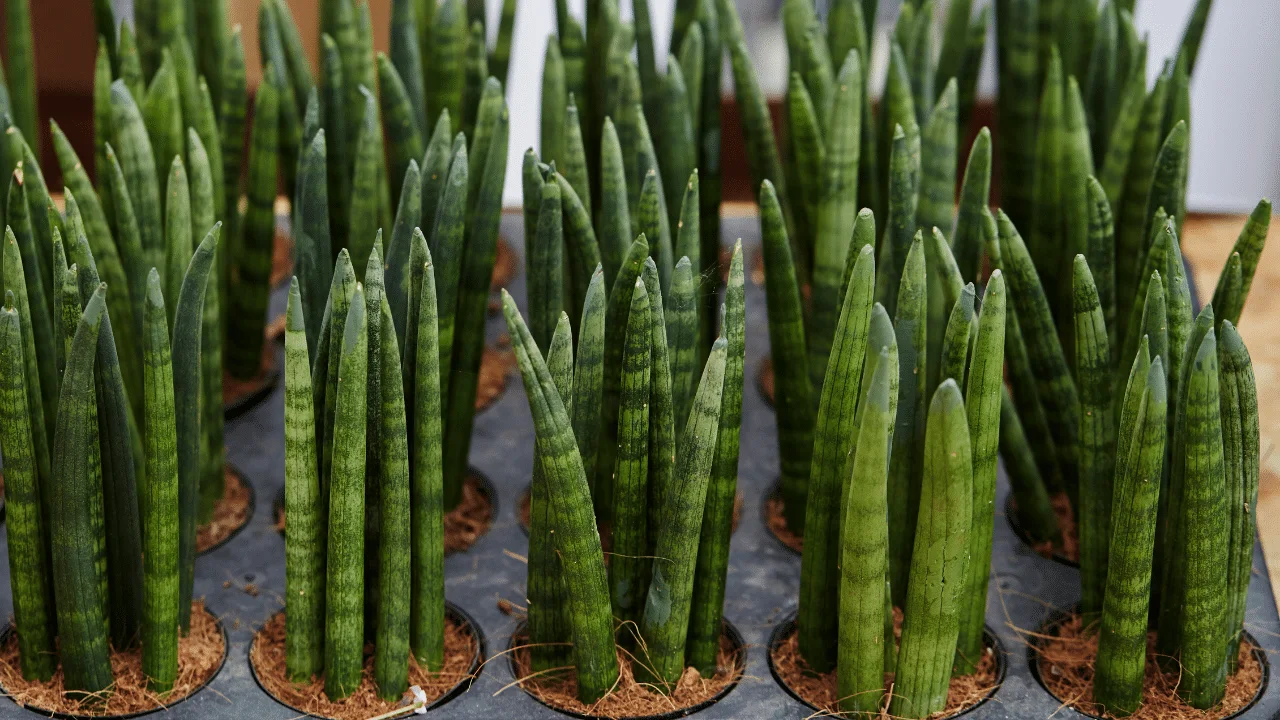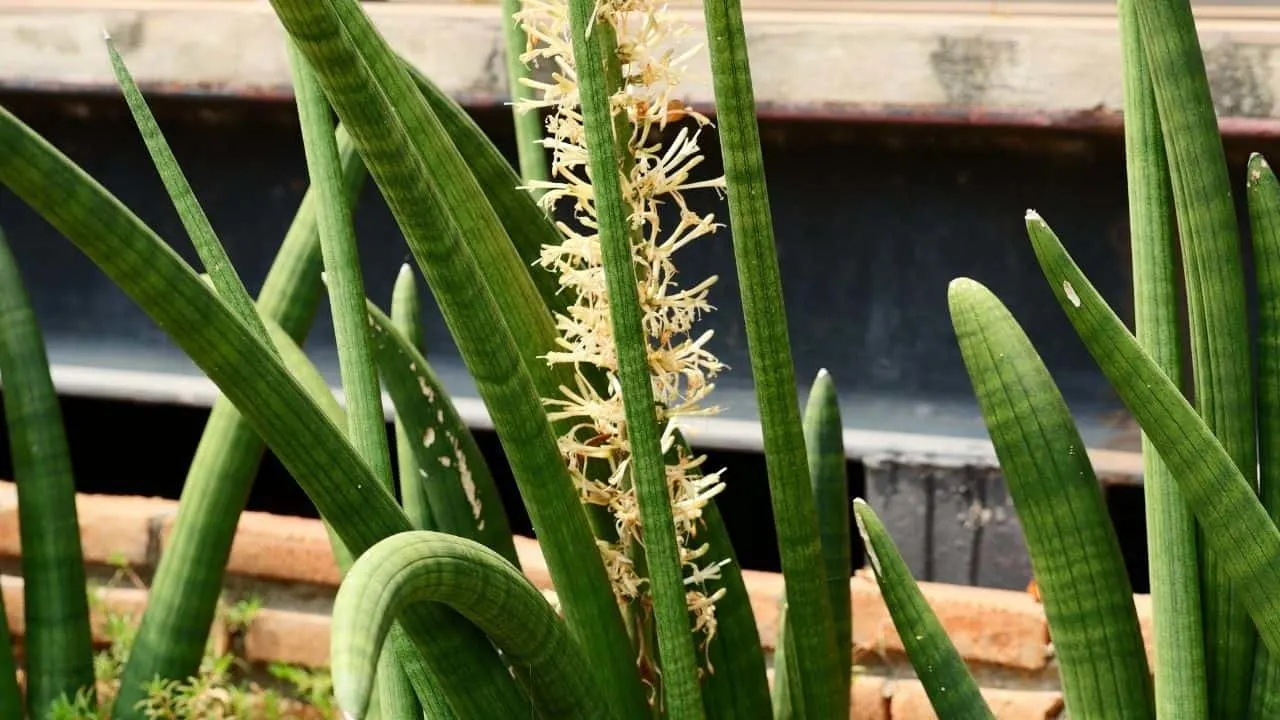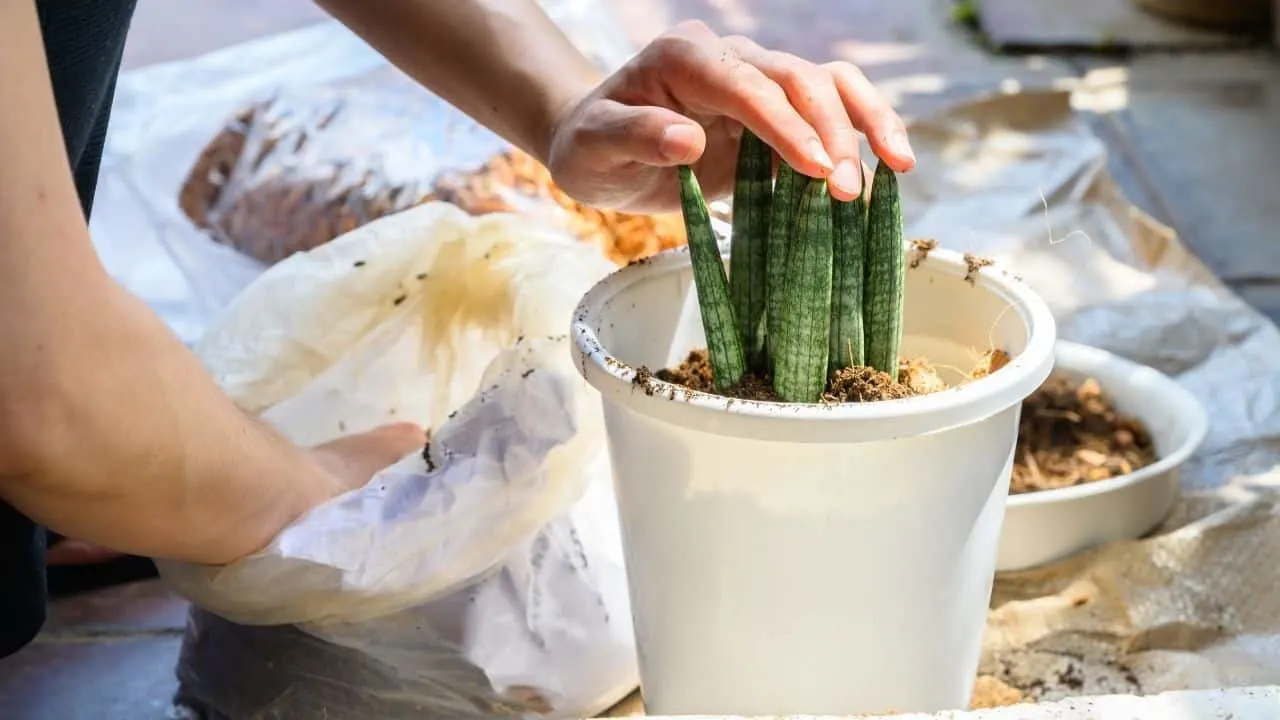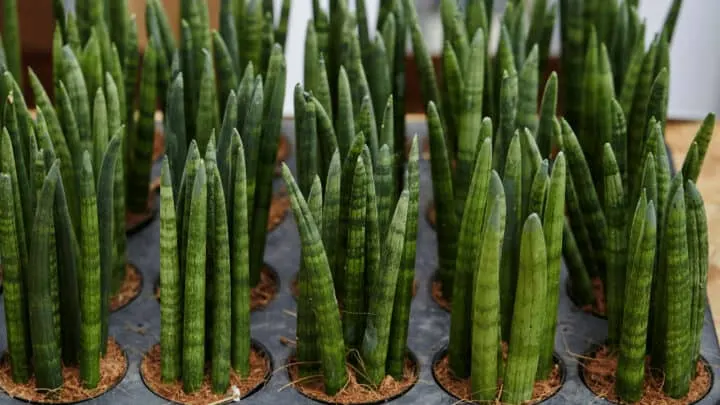Sansevieria cylindrica or also called Dracaena angolensisare or African spear plant are among my all-time favorite plants because of their easy maintenance, stylish looks, and ability to grow in a wide variety of conditions.
If you’re new to plant ownership or want a houseplant that needs minimal care, a Sansevieria will be your right choice!
Sansevieria plants have stiff, upright leaves that look like swords. Architecturally speaking, they are a good choice for a modern or contemporary interior design.
These plants are native to Africa, Southern Asia, and Madagascar, and for those who are planting, enthusiasts fall under the family Asparagaceae.
Fun Fact: The thing I love about Sansevieria cylindrica is their unique type of photosynthesis at night. Snake plants release oxygen even during nighttime!
Sansevieria cylindrica Care
For Sansevieria cylindrica bright indirect sunlight is the best. Water every 2-3 weeks only. The temperature should be between 68 and 85 degrees Fahrenheit (20 and 29 degrees Celcius). Provide soil using succulent and cactus mix in a 1:1 ratio adding in some perlite and pumice. Humidity should be around 40%. Use a regular houseplant fertilizer no more than twice in Spring and Summer and do not fertilize in Autumn and Winter.

Sansevieria cylindrica Care
Table of Contents
Sansevieria cylindrica Care Guide – 12 Best Tips
1. Soil
Sansevieria cylindrica care does not have any particular nutrient requirements. Sansevieria Cylindricas tolerate 4.5 to 8.5 pH levels, with 5.5 to 7.5 being ideal.
To prevent root rot, I’d recommend using well-draining and loose soil.
Choose potting media with a low peat content. In most situations, peat works well; however, it often becomes tightly packed and may not drain or rehydrate correctly.
What works best for me is a combination of succulent and cactus mix with potting soil in the ratio of 1:1.
I add a few handfuls of perlite or pumice to increase aeration and drainage if the mix seems too heavy. Similarly, I’ll do this if the pot only has 1-2 drain holes.
Read our article on The Best Soil For Snake Plants for further guidance.
2. Light
Although Sansevieria cylindrica care requires bright indirect light (10′ away from the south or west window), they can also tolerate dim light or some direct sunlight.
You see how impressively versatile they are! However, do not keep them in the direct sun for too long because they will burn.
Read more at Why Is My Snake Plant Dying? All You Need to Know!
3. Watering
It is easy-going with the watering; however, this is important for Sansevieria cylindrica care. It is important not to overdo it as the plant will rot.
Be sure that you thoroughly water it again only when the soil’s completely dried.
I water my snake plant every 2-3 weeks in summer and every 8 weeks in winter when the sun is less intense. Plants like to take a break during the winter months.
Note: Don’t let water collect in the center of the leaves (where they form a cup), as this may cause the plant to become mushy and eventually rot.
So, if you travel a lot or tend to ignore plants in general, then this is the perfect plant for you.
Read our article on Snake Plant Root Rot ― Identification, Treatment, Prevention, and Overwatered Snake Plants – All You Need To Know! for further guidance.
4. Temperature
The temperature for Sansevieria cylindrica should be between 68 and 85 degrees Fahrenheit (20 and 29 degrees Celcius).
Sansevieria Cylindrica care doesn’t force you to follow a strict temperature range. They can survive various temperature ranges in our homes.
When you are comfortable in your house, it will also be appropriate for your Sansevieria cylindrica care.
Generally, snake plants grow best in warm conditions and will suffer if the temperature falls below 50 degrees Fahrenheit (10 degrees Celsius).

Sansevieria Cylindrica in Warm Area
Set this plant in an area away from drafts.
Moreover, this plant cannot survive frost and avoid placing them near vents or heating or air conditioning systems.
5. Humidity
Sansevieria cylindrica care requires a dry environment.
They usually grow best in 40% humidity.
6. Fertilizer
You might consider using a natural all-purpose houseplant food if you prefer adding fertilizer in your Sansevieria cylindrica care.
Just ensure to fertilize the Sansevieria cylindrica during summer and spring, and no more than twice. Snake plants don’t require lots of fertilizer.
It’s not a good idea to fertilize houseplants during winter or late in fall as that’s their resting season.
Don’t fertilize plants that are stressed, such as those that are bone dry or soaking wet.
7. Pest
Growing these plants is easy, and they last for quite a long time. Sansevieria cylindrica is also commonly resistant to pests.
Fortunately, many common pests do not like them!
Since this healthy plant will not be affected by pests or diseases, so it is perfect for newbies.
8. Toxicity
Unfortunately, Sansevieria cylindrica is toxic to pets, according to ASPCA. Therefore, keep your cats and dogs away from it, especially if they are likely to try to bite one!
Luckily my cats never try to chew any of my Snake Plants, maybe because they don’t look as appetizing as crunchy leaves like a Spider Plant.
I don’t test how toxic a plant may be for my pets and rely entirely on authentic sources to gather information on this topic.
Therefore, I would recommend conducting a little more research regarding this topic and coming up with your conclusion.
9. Propagation

Propagating Sansevieria cylindrica
The best time to propagate is during the growing season, probably during the spring or summer.
Snake plants are easy to divide when repotting as long as they’re at least four inches tall.
It is also possible for new shoots to emerge from the soil and to be potted independently. Cuttings are another way of propagating snake plants.
Find the detailed step-by-step guide under the step-by-step propagation heading.
10. Growth
The growth rate of Sansevieria cylindrica is slow to moderate. It reproduces by underground stems known as rhizomes, which appear as new growth.
They grow faster in brighter light and slower in dim light.
Usually, snake plants are grown as houseplants and range in height from 8″ to 7′.
11. Potting
Choose a potting material that’s sturdy and durable since strong roots can break weak pots.
Sansevieria cylindrica is generally a slow grower that requires little repotting, but if given enough sunshine, they may grow rapidly, requiring repotting or division.
Spring’s the optimum time for repotting these plants.

Sansevieria Cylindrica Repotting
Whenever you repot, use fresh soil, cactus potting mix, or a combination of both for proper Sanseveria cylindrica care.
Generally, I repot my Snake plants every two to five years at most. Repotting every 5-10 years will work if yours grow slowly and in low light.
12. Pruning
To promote new growth, cut off damaged or mature leaves or remove the leaves using sterile scissors, sharp knives, or pruning shears.
The best time to prune Sansevieria cylindrica is during summer or spring.
It’s okay to prune in the off-season as well, but if you don’t want to stress out your plant, it’s better to prune when the plant is in growth mode.
Remove the tallest leaves of your snake plant to control its height. In addition, remove leaves that have been damaged. By doing so, new leaves will grow.
In-depth Sansevieria cylindrica Propagation with Different Methods and Step-by-step Guide
Propagation through Root Division
- Get yourself a clean pot, a sharp knife, and cactus potting soil.
- Then, remove the root ball from its old pot and put it in a surface that’s flat. Remove soil from the roots or rhizome by brushing it gently with your hand.
- With the sharp knife, cut the plant into sections, ensuring the roots for every portion remain intact. Doing so will not harm or kill your plant.
- Put cactus potting soil in a clean pot and replant your new snake plant sections.
- Provide it with water and put it in a partly sunny location for proper Sansevieria Cylindrica care.
Propagating Sansevieria cylindrica pups
- If you observe any Sansevieria cylindrica pups or offshoots that have developed on your plant, you can plant them separately.
- You will need a clean pot, a sharp knife, and cactus potting soil for root division.
- Pull out the root ball, locate the pup’s root, and cut off the baby offshoot. Place the cut root end into the cactus potting soil.
- Place it in an indirect bright light location and water it for appropriate Sansevieria cylindrica care.
Propagation through leaf-cutting
- Cut off a long, healthy leaf with sterilized scissors, a knife, or pruning shears from your snake plant.
- Place the leaf-cutting in a clean glass or jar of water to root and submerge the cut end in the water. Place the jar in a partially sunny area and observe the root growth.
- Ensure the water level is maintained every few days by topping it off. To prevent bacterial or algae growth, replace the old water every two weeks with clean water.
- Plant the roots in a well-drained cactus potting mix when the roots reach an inch long.
- Provide it with water and put it in a partly sunny location for proper Sansevieria Cylindrica care.
Water rooting can be skipped if you want. Once a healthy leaf has been cut off of your plant, let the cut end to callus over for 24 hours before potting it in the cactus potting mix, cut-end down.
Since Sansevieria Cylindrica is a slow-growing plant, it may take 2 months for it to grow.
Sansevieria cylindrica Problems
Root rot
Root rot is a common problem when caring for Sansevieria cylindrica. The reason are either using incorrect non well-draining soil or overwatering your plant.
Usually it is a combination of both as overwatering often happens when soil is too compact. Also do not water these plants more than every 2 weeks as these are succulent plants that need little water only.
Soggy soil will lead to root rot that can be identified by soft, mushy roots. When you suspect root rot do the following:
- Remove your plant from the pot
- Check the roots and see if they are soft and mushy
- If so remove the soil, cut off all the mushy roots
- Wash the remaining roots under running water
- Remove the old potting soil
- Disinfect the pot using rubbing alcohol
- Replace the soil with new well-draining potting soil
- Water every 2-3 weeks only
Pests
Sansevieria cylindrica pests include spider mites, mealybugs, scales, gnats, aphids, and whiteflies.
By maintaining your snake plant, you can avoid insect invasions. Insects usually occur when the plant’s environment is unfavorable, such as incorrect water levels or humidity.
For Sansevieria cylindrica care, remove insects from your plants by picking them off, spraying them lightly with water, or applying organic neem oil to keep them away.
Foul-smelling Soil
Root rot is likely to be present if you notice rotting smells in the soil. Take a handful of soil and smell it. Rotting roots smell foul.
The plant can be saved, but you’ll need to examine the roots closely to ensure that the roots are protected in time.
For Sansevieria cylindrica care, make sure to remove the root ball from its pot in a gentle manner. If the roots or leaves appear brown or mushy, remove them.
A portion of a healthy root rhizome should be repotted with fresh cactus potting soil or well-draining potting soil.
Rhizomes that can’t be saved should be discarded. Take leaf cuttings to propagate new snake plants.
Yellow or Brown Leaves
Snake plant leaves display some yellow or silver streaks when they are healthy. Brown or yellow leaves may result from various conditions, including root rot, overwatering, or pests.
Managing the plant’s water level effectively will cure these conditions and achieve proper Sansevieria cylindrica care.
The root rot that results from overwatering can make the plant more vulnerable to pests.
Curling Leaves
The thrips are one of the most common pest infestations that cause curled leaves. For Sansevieria cylindrica care, check your plants’ leaves closely with a magnifying glass.
But, you can deal with these tiny black bugs using simple solutions.
You can spray vegetable soap or neem oil to send the pests away. Remove any severely curled leaves. You will eventually get new ones.
Read our article on Curly Leaves on Snake Plants — A Thing of the Past! For more information.
Drooping or Falling Leaves
Leaves stand upright or grow upward in healthy Sansevieria cylindricas. But too much water, poor potting materials, or too little light can cause the leaves to either droop or flop.
A poorly-draining potting mix causes the soil to become soggy and causes foliage problems.
For proper Sansevieria Cylindrica care, the plant might need to be relocated to a brighter location, the watering frequency reduced, and the soil changed to one that drains better.
Also, read our article on Why is My Snake Plant Not Growing? — Well, Here’s Why for more details.
Tips to Keep Sansevieria Cylindrica Problem-Free
Follow these tips to achieve appropriate Sansevieria Cylindrica care in your house:
- Avoid over-watering the plant.
- Ensure the soil’s completely dry before its next watering session.
- Ensure no water collects in the center of the leaves when watering.
- For best results, keep Sansevieria cylindrica in indirect light.
- Take special care and water every 8 weeks in the winter.
- Fertilize Sansevieria cylindricas mainly spring and summer.
- Avoid keeping it in temperatures less than the 50 degrees Fahrenheit mark.
- Use well-draining and loose soil for potting.
How tall do Sansevieria cylindrica grow?
Grows up to 6 feet in height (1.8m) and 4 feet in width (1.2m). Indoors it will grow up to 3 feet (90cm). It is a slow growing succulent plant.
Is Sansevieria cylindrica a succulent?
Sansevieria cylindrica is a succulent plant. It has fleshy horizontal leaves that are green and point upwards. Succulent plants use leaves and stems to store water.
How often should you water Sansevieria cylindrica?
Water no more than every 2-3 weeks once the top 2-3 inches of soil are completely dry to the touch. As they are succulent plants, they are succeptible to overwatering.
What is the difference between Sansevieria bacularis and Sansevieria cylindrica?
Sansevieria bacularis and Sansevieria cylindrica are not the same plant altough they belong to the same genus Sansevieria and family Asparagaceae. The Cylindrica has much thicker leaves and grows more compact compared to the Bacularis. In addition, the max height of Bacularis is about 2 feet smaller (60cm).
Why is my Sansevieria cylindrica dying?
There are many reasons for these plants to die. The two most common reasons are underwatering and overwatering.
To identify overwateirng put your index finger into the soil and check if the soil is still wet after 1-2 days. Underwatering happens when you have not watered for 3 weeks and more and the leaves are starting to shrivel up.
Can you cut Sansevieria cylindrica?
You can cut these plants with no adverse effects. However the African spear plant does not need pruning.
Pruning will be done solely for the looks of these succulents. You can cut back overgrowing or unruly leaves or cylinders. Never cut back all of the leaves as this will stunt the growth of your plant.
Is Sansevieria cylindrica an indoor plant?
Cylindrical snake plant benefits
Snake plants have multiple benefits such as:
- Remove toxins from the air
- Release oxygene to the atmosphere at night
- Relief stress
- Limited care requirements
- Can be grown in a small space
The NASA mentions Snake Plants in its study about plants that remove toxins from the air as one of the plants that are suited to filer pollutants from the air and thus clean it.
The Mother-in-Law’s tongue (in the study it was a Sansevieria laurentii) removed a total of 31,294 micrograms in a 24 hours period per plant.
How to Braid Sansevieria cylindrica
- To braid a Sansevieria cylindrica make sure that you have two plants and two rubbers bands
- Take the plants out of the soil
- Stack the plants on top of eachother and start at the base
- Secure the base with a rubber band
- Always go from left to right and bride the plants from the base to the top
- Do it slow and make sure the braiding is tight
- In the end fix the top with a second rubber band close to the top
Sansevieria cylindrica flower
These plants flower from the leaf base of mature plants. They produce a flower spike with white flowers along the spike on each side. The flowers are small and fragile.
Sansevieria cylindrica varieties
There are several varietis of Sansevieria cylindrica such as:
- Sansevieria cylindrica ‘Skyline’
- Sansevieria cylindrica ‘Dragon Fingers’
- Sansevieria cylindrica ‘Patula’
- Sansevieria cylindrica ‘Stukii’
- Sansevieria cylindrica ‘Spaghetti’
- Sansevieria cylindrica ‘Starfish’
Sansevieria cylindrica new growth
New growth appears as underground stems. These plants have rhizomes that are growing underground and new leaves will shoot up as pups from the soil.
The new growth can be used to propagate the African spear plant. You can remove it by either using a clean scissors or knive.
Frequently Asked Questions About Sansevieria cylindrica Care
How long does Sansevieria cylindrica live?
Generally, they live up to 5 – 10 years; however, they can live for 25 years or even more under proper care.
How can I prevent my Snake Plant from rotting?
For proper Sansevieria Cylindrica care, water deeply but less often. This should be done weekly or biweekly, ensuring the top layer of soil is dried out. The constant moisture in the soil promotes root rot.
How would I know if my Sansevieria cylindrica plant is healthy?
If your sansevieria is healthy and well-nourished, it should have dark green, straight, and pest-free leaves.
What’s the best way to keep my Snake Plant healthy?
Pruning snake plants makes them grow straight. It is necessary to prune snake plants to make their leaves grow bushier. As with other plants, snake plants also need to be pruned.
How would I know if I’m overwatering my Sansevieria Plant?
A mushy brown stalk is overwatering-related. Reduce the water you’re providing and prune the plant. Once the soil is completely dry throughout the pot, your plant is ready to be watered.
How would I know I’m underwatering my Sansevieria Plant?
It is not impossible to underwater a Sansevieria, but the results are dry, crispy tips on the leaves. Pruning and more frequent watering may be necessary if this is the case.
Can I grow my Sansevieria in extremely low light?
Your plant can grow in this condition, but the growth will be stunted. Additionally, overwatering becomes more likely when you place your plant in low light conditions, so take extra care when doing so.
Conclusion About Sansevieria cylindrica Care
To care for Sansevieria cylindrica provide temperatures between 68 and 85 degrees Fahrenheit (20 and 29 degrees Celcius). Water every 2-3 weeks and provide bright indirect light. Keep humidity low at 40% or less. Fertilize using regular houseplant fertilizer every two months in spring and summer and reduce fertilization in autumn and winter.

Daniel has been a plant enthusiast for over 20 years. He owns hundreds of houseplants and prepares for the chili growing seasons yearly with great anticipation. His favorite plants are plant species in the Araceae family, such as Monstera, Philodendron, and Anthurium. He also loves gardening and is growing hot peppers, tomatoes, and many more vegetables.


